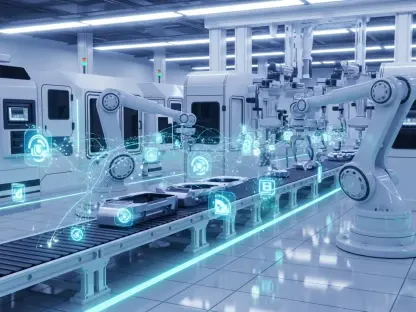Edge computing is transforming the manufacturing sector by providing localized data processing that enhances operational efficiency, resiliency, and cybersecurity. By processing data closer to its source, manufacturers can achieve real-time decision-making, minimize costs, and improve overall system security. This article delves into the many advantages of edge computing and explores its impact on various aspects of manufacturing operations.
The Basics of Edge Computing in Manufacturing
What Is Edge Computing?
Edge computing refers to the decentralized approach of processing data near its point of origin, such as sensors and local devices, instead of relying on central systems. The proximity to data sources allows for quicker data processing and real-time analytics, significantly reducing latency and enhancing overall efficiency. In traditional centralized computing systems, data has to travel to a central server to be processed and then returned to the point of action. This process introduces latency, which can be detrimental in manufacturing environments where milliseconds count, and decisions need to be made in real time to maintain optimal operations.
The advantage of lower latency is perhaps the most noticeable when manufacturers deal with large volumes of data generated by multiple sensors and devices. The closer the processing power is to these sensors, the quicker the data can be analyzed and acted upon. This allows for real-time interventions, whether it’s adjusting machinery settings, rerouting products on an assembly line, or detecting and correcting potential faults before they result in costly downtimes. Thus, the decentralized nature of edge computing meets the urgent need for speed and efficiency in modern manufacturing.
Overcoming Integration Challenges
Although the cost of edge computing technology has significantly decreased, integrating these new systems with existing legacy infrastructures remains a challenge. The dropping cost of silicon and other technological advancements have made edge computing hardware more affordable and accessible. However, manufacturers often have longstanding legacy systems that weren’t designed with modern edge computing in mind, leading to compatibility issues. Addressing these challenges involves not only technical solutions but also strategic planning and a willingness to invest in updates and training.
One of the main hurdles in integration is ensuring that edge computing devices can communicate effectively with existing systems. Manufacturers need to deploy new hardware and software that can seamlessly interface with legacy equipment without causing disruptions. This may involve using middleware solutions that act as intermediaries, translating data formats and protocols to ensure smooth communication between old and new systems. In addition, implementation often requires a phased approach where edge computing capabilities are introduced gradually, allowing for testing and validation before full-scale deployment.
Enhancing Operational Efficiency
Reducing Latency
Localized data processing eliminates the need to transfer large amounts of data to centralized systems, significantly reducing latency. This allows for faster decision-making and more responsive operations, which is crucial for maintaining competitiveness in the manufacturing sector. For example, in a manufacturing plant, milliseconds can mean the difference between catching a defect early in the production process and having to deal with prolonged equipment downtime or product recalls. This reduction in latency ensures that decisions are made almost instantaneously at the point of data generation, which enhances the efficiency and responsiveness of operations.
To illustrate, consider a scenario in which sensor data indicates an unusual vibration pattern in a piece of machinery. With edge computing, this data can be processed on-site in real time, immediately triggering a corrective action such as adjusting the machine’s operation parameters or shutting it down for maintenance. This rapid response reduces wear and tear on equipment, minimizes downtime, and prevents more severe failures. As operations become more data-driven, the importance of low latency cannot be overstated in achieving higher efficiency and reliability in manufacturing processes.
Lowering Communication Costs
By minimizing data transfer between local devices and central servers, edge computing reduces communication costs. This not only saves on bandwidth expenses but also alleviates the load on central networks, enhancing overall operational efficiency. Centralized systems often involve the continuous transmission of large volumes of data to a cloud or central server, leading to significant bandwidth consumption and higher operational costs. Edge computing, by processing data at or near the source, dramatically cuts down on the amount of data that needs to be transferred through networks.
Reducing communication costs entails more than just cutting expenses; it also impacts system performance and reliability. Lowering the data load on central servers means these systems can perform more efficiently and handle critical tasks with reduced risk of bottlenecks or overloads. Additionally, the savings on communication costs allow manufacturers to allocate resources to other strategic initiatives, like upgrading infrastructure or investing in advanced analytics capabilities. This reduction in communication overhead also provides a more scalable framework, allowing operations to expand without proportionately increasing network and data transfer costs.
Resiliency and Continuity in Manufacturing
Ensuring Operational Resiliency
Edge computing enhances the resiliency of manufacturing operations by localizing key processes. By decentralizing data processing, manufacturers reduce the dependency on centralized systems that can be susceptible to disruptions, such as network outages or cyberattacks. This means that even during network outages or other connectivity issues, localized systems can continue to function autonomously, reducing the risk of complete operational shutdowns. The capability to operate independently ensures a higher degree of operational continuity and mitigates the risk associated with central points of failure.
In practice, this means that different zones or departments within a manufacturing facility can continue their operations seamlessly even if the main server or network connection is disrupted. For example, if an external cyberattack were to compromise the central network, localized edge devices would still be able to process data, make critical decisions, and maintain production continuity. This decentralized yet unified operational approach translates to lower vulnerability and higher resilience against disruptions, whether they are technical, deliberate, or accidental in nature.
Modular Manufacturing Setups
The modularity enabled by edge computing allows manufacturers to quickly reconfigure production capabilities. This flexibility is particularly valuable during supply chain disruptions, enabling swift adaptation to changing circumstances and maintaining production continuity. In manufacturing, adaptability is critical, especially in the face of unforeseen events like the COVID-19 pandemic, which caused significant disruptions in global supply chains. Edge computing facilitates a modular approach, where production units can be quickly reprogrammed or relocated to respond to supply chain or demand fluctuations.
The ability to reconfigure manufacturing setups on the fly offers a critical advantage for maintaining operational robustness. Modularity means that individual units or cells within the manufacturing plant can operate independently or be redeployed as needed, without bringing the entire operation to a halt. This approach can mitigate the impact of external disruptions by providing alternative pathways to keep production lines running. Moreover, modular setups facilitated by edge computing support the rapid deployment of new production lines, enabling manufacturers to experiment with new configurations and optimize their processes for better efficiency and output.
Predictive Maintenance Capabilities
Real-Time Data Processing for Maintenance
Edge computing facilitates predictive maintenance by enabling real-time or near real-time data processing from sensors monitoring various machine conditions, such as vibration, temperature, and oil quality. Traditional preventive maintenance schedules are often based on historical data and fixed time intervals, which may lead to either premature maintenance or unanticipated failures. With edge computing, manufacturers can shift from preventive to predictive maintenance, allowing real-time analysis of equipment health and performance data. This immediate insight into the operational status of machinery allows manufacturers to detect potential equipment failures early and take proactive maintenance actions.
The real-time analytics capabilities of edge computing mean that any deviations from normal operating conditions can be instantly identified and addressed. For instance, if a sensor detects an abnormal vibration pattern, the edge computing device can analyze this data in real time and flag it for immediate intervention. This shift to predictive maintenance extends the lifespan of machinery, reduces unplanned downtime, and enhances overall operational efficiency. Furthermore, predictive maintenance driven by edge computing not only leads to cost savings by avoiding catastrophic machinery failures but also optimizes resource allocation by scheduling maintenance activities only when they are truly necessary.
Types of Data Collected for Maintenance
Sensors on edge devices collect various types of valuable data, including vibration monitoring, noise levels, temperature, oil condition, and usage data. Analyzing this data helps identify anomalies and ensures timely maintenance interventions, thereby extending the lifespan of machinery and reducing downtime. Each type of data provides distinct insights into the condition and performance of equipment. For example, vibration monitoring is crucial for detecting imbalances or misalignments in rotating machinery, while noise level analysis can identify issues related to bearings or gears. Temperature data can reveal overheating problems, and oil condition monitoring indicates lubrication efficiency and potential contamination.
All these different data types are processed at the edge to provide a comprehensive view of the machine’s health. By synthesizing this information in real time, edge computing devices can generate actionable insights that are immediately useful for maintenance decision-making. This comprehensive monitoring and analysis framework leads to more precise and effective maintenance strategies. Predictive maintenance enabled by edge computing thus transforms how manufacturers manage their equipment, leading to significant improvements in reliability, efficiency, and cost-effectiveness.
Optimizing Supply Chains and Production
Adapting to Supply Chain Disruptions
Edge computing plays a crucial role in optimizing supply chains by facilitating real-time monitoring and quick adaptation to disruptions. During the COVID-19 pandemic, for example, edge computing technologies helped manufacturers maintain operational flexibility and minimize the impact of supply chain disturbances. Real-time data from edge devices allows manufacturers to quickly identify supply chain bottlenecks and reroute resources as needed. This agility is essential in a globalized manufacturing environment where disruptions can have cascading effects across the entire supply chain.
Manufacturers can deploy edge computing to enhance visibility across their supply chains, from raw material sourcing to final product delivery. The ability to track and analyze data in real time enables quicker responses to disruptions. For instance, if a critical supply route is suddenly blocked, edge computing systems can immediately propose alternative routes or sources, ensuring minimal impact on production schedules. This real-time adaptability not only preserves the continuity of operations but also provides a competitive advantage by allowing manufacturers to respond faster to market demands and unexpected challenges.
Improving Production Scheduling
Accurate, real-time data provided by edge computing allows manufacturers to optimize production scheduling, ensuring efficient use of resources and meeting demand effectively. This adaptability contributes to overall operational efficiency and productivity. Traditional production scheduling often relies on historical data and forecasts, which may not account for real-time changes in demand or unexpected disruptions. Edge computing enables dynamic scheduling by continuously feeding real-time data into the production planning process, allowing for immediate adjustments based on current conditions.
For example, if sensor data indicates that a particular production line is operating below capacity, the edge computing system can automatically adjust schedules to allocate more work to that line or suggest maintenance to bring performance back to optimal levels. This kind of real-time adjustment ensures that resources are used efficiently and production targets are met promptly. By providing a timely and accurate picture of the manufacturing environment, edge computing supports better decision-making and enhances overall productivity.
Strengthening Cybersecurity
Minimizing Attack Surfaces
By processing data locally, edge computing reduces the need for extensive data transfers, which minimizes potential attack surfaces. This decentralized approach mitigates the risk of unauthorized access and enhances the protection of critical systems. Cybersecurity is a paramount concern in modern manufacturing, where interconnected systems and extensive data transfers between devices and central servers present multiple vulnerabilities. Edge computing, by limiting the amount and range of data transmission, inherently reduces these vulnerabilities.
The decentralized architecture of edge computing confines sensitive data to local environments, restricting the pathways that potential attackers could exploit. This minimizes the exposure of critical data and reduces the risk associated with large-scale data breaches. Furthermore, localized processing means that even if a part of the network is compromised, the impact is contained, and the rest of the operation can continue unaffected. This compartmentalization is essential for maintaining the integrity and security of manufacturing operations in an increasingly interconnected and vulnerable digital landscape.
Enhanced Data Security
Edge computing is revolutionizing the manufacturing sector by enabling localized data processing, which boosts operational efficiency, increases resilience, and heightens cybersecurity. Unlike traditional central data processing methods, edge computing processes data closer to its source. This proximity allows manufacturers to make real-time decisions, reducing latency and improving responsiveness. The closer data processing also helps in cutting down operational costs and bolstering overall system security by minimizing the data that needs to travel across networks, thus reducing vulnerabilities.
Manufacturers can harness the power of edge computing to monitor equipment performance, optimize predictive maintenance, and streamline supply chain operations. Real-time analytics enable faster troubleshooting and preventive measures, leading to reduced downtime and enhanced productivity. Additionally, edge computing facilitates greater automation and more sophisticated quality control processes.
The adoption of edge computing also means manufacturers can become more adaptable to changes and demands. Enhanced data privacy protocols ensure that sensitive information is more secure, mitigating risks associated with cyberattacks. The integration of these technologies into manufacturing operations represents a significant shift toward more intelligent, efficient, and secure production environments. This article explores these transformative benefits and the substantial impact of edge computing on the future of manufacturing operations.









